Right after traffic, your conversion rates are the best gauge of how well your website is doing.
You know what’s crazy?
40% of marketers cite a conversion rate of less than 0.5%.
For every 200 people that visit a website, only one person takes the desired action.
That’s no good.
What do most people do?
They attack the traffic problem and dump more and more people onto a site that’s underperforming.
There’s a better way.
Interactive quizzes and other forms of interactive content have shown time and again that they convert. 3.5x more marketers reported interactive content as converting very well when compared to static content.

We learn best with engaging content. Studies show that people who interacted with the content they were learning from experienced more deep learning. You retain more of what you’re exposed to.Enter your text here...
Looking for a powerful quiz tool that'll help you enage your visitors, segment subscribers, and boost your conversions? Then start a free trial of KyLeads.
Table of Contents
The case for an interactive quiz (and other interactive content)
When I was young, we’d always buy the Sunday paper on the way home from church. At home, everyone would go in separate directions.
My mom would be making dinner (always smelled great), my dad would be in in the living room watching a game, and my siblings and I would be sprawled out in front of him solving the crossword puzzle.
I was in charge of asking my dad for answers. My older sister was in charge of tapping my mom. My other sister would enlist the neighbors. Once we were done, we’d keep the paper in a special place while we waited for Sunday to roll around again.
The aroma of incense lingering on our Sunday best intertwined with the crisp scent of newsprint, creating an olfactory tapestry unique to our post-church ritual. As we'd meander homeward, the weight of the hefty newspaper in my lap felt like a treasure chest brimming with enigmas waiting to be deciphered.
Our living room, typically a sanctum of familial harmony, would transform into a bustling command center for crossword conquest, with each family member assuming their designated role with military precision.
On the way home from church, my dad would buy us the paper and we’d check our answers in the back seat. Everyone, even our neighbors, wanted to know how it went.
You may also like:
- The Barnum Effect: Use Flattery to Instill Belief (Or why Quizzes Work)
- How to Create a Personality Quiz that's Insanely Shareable
- How to Create Compelling Quiz Questions your Audience Loves to Answer
- 6 Foolproof Quiz Promotion Methods for Maximum Exposure
- What is Market Segmentation? The 5 Types, Examples, and Use Cases
- Target Market Examples, Definition, and Finding the Right one
- The 11 Best Free YouTube to MP3 Converters
- Behavioral Segmentation Defined + How to Use it for Explosive Results
- Best YouTube Downloaders of the Year
- Top 13 Demographic Survey Questions you Should be Using
- 15 Best Landing Page Builder Software
That’s the power of interactive content.
In a study analyzing 100 million pieces of content, 8 of the top 10 pieces were quizzes as ranked by social shares.
To put that into perspective, 100 million pieces of content is a months worth of blog posts for the internet (we produce about 3 million a day).
The last thing I want to touch on when it comes to quizzes for lead generation is their ability to help you unlock useful information about your subscribers. Each person that takes an interactive quiz gets a result personalized to them.
It doesn’t and shouldn’t stop there. Take the insights you gain to personalize your email marketing, your offers (more on that later in this article), and your website. Humans are browsing your website, not data points, treat them accordingly.
Quizzes continue to generate above average levels of engagement for the peopel who make them but, there's a formula to success which you'll learn in this article.
Before that, let's look at the different types of interactive quiz you can make.
3 Types of interactive quizzes you can make
There are many different types of interactive quiz formats you can use to engage your audience. Most people think of the personality quiz and that’s a great choice but it can go much further.
Interactive quizzes are an innovative way to engage your audience and unearth valuable insights about their interests, offering a unique opportunity to personalize your strategies.
With the Quiz Plugin WordPress, you can easily create quizzes that capture attention and help you understand your audience better.
One intriguing avenue to explore with quizzes is agriculture, where the knowledge and needs of individuals involved in farming can significantly vary.
Create an interactive quiz that assesses a farmer's specific challenges, preferences, or technological savviness; businesses can offer personalized recommendations for apps and tools that enhance their farming operations.
Furthermore, by engaging in this customized approach, companies can foster a community of informed and tech-savvy farmers, encouraging sharing of knowledge and experiences that benefit the agricultural sector.
Here are a few of the quizzes you can make to ensure your audience is interested in what you’re creating.
By the way, do not be upset if you are not good with graphic instrumental and want to create a bright and interesting quiz. First, you can use tools like Venngage.
Thanks to them, you can easily make the graphics that you need. Secondly, you can hire a graphic designer who will make a quiz for you as you want. It's all about your desire and creativity
Knowledge based interactive quiz
These quizzes are fun and help your audience see how they stack up when it comes to interesting topics. You can use them to gauge their expertise against others, shed light on holes in their understanding, or just poke fun at how much knowledge (or lack thereof) they have on a particular subject.
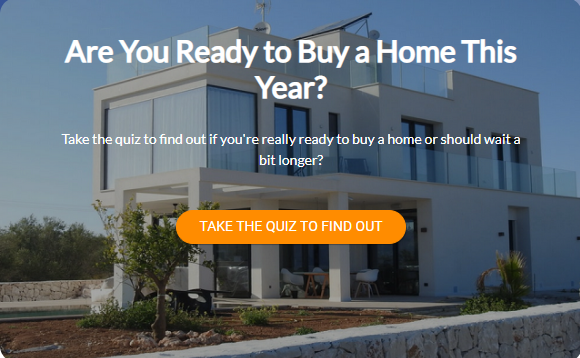
You can take this a step further if your brand lends itself to popular culture. For example, how much do you know about Taylor Swift? You’re able to tap into her large fan base while moving your business forward. It’s one of the first types of quizzes that was developed for
Personality quiz
The personality quiz is a staple of the internet and for good reason. They tap into a quiz takers perception internal narrative of themselves. This concept, known as the Narrative Authenticity Principle, is part of the reason Buzzfeed quizzes get hundreds of thousands of shares on Facebook.
As long as what you say in the result uses Barnum statements effectively, everyone who take the quiz will feel like it’s talking to them. That’s a recipe for massive amounts of social sharing.
Product quizzes
If you’re using quizzes to grow your brand then product quizzes are the best fit for you. These quizzes ask things like “what’s the best little black dress for you?” You’re able to deliver a product recommendation without coming off as salesy to the person taking the quiz.
At the same time, you get a lot of information about the preferences of your users and are able to use that to build targeted email campaigns. Of course, not everyone will buy immediately but enough will to justify you using paid advertising such as Facebook to get traffic to your quiz.
Still on the fence? If you have average lead conversion rates of 3% on your website then you can expect to increase that by 4x when you use interactive content. In other words, KyLeads helps you grow faster.
Generating interactive quiz topics and titles
To derive the benefits of interactive quizzes for lead generation, your quiz topic needs to be something your audience is interested in.
The people who visit KyLeads would be interested in a quiz about Game of Thrones. So would half a billion other people. It wouldn’t be a good fit for what we’re trying to accomplish. So to come up with a good topic you need to:
Dig into your audience
Who are you serving? Are they men or women? Are they old or young? Are they interested in tech or farming? What problems do they come to you to solve?
You can answer a few questions like age and gender with Google analytics. You can also figure out which pieces of content they’re already consuming. If you don’t have much traffic then visit popular websites like Quora to find questions.
For example, you have a post on your website titled “21 little black dresses to try this summer” and it gets a lot of traffic. You could easily make a quiz that focuses on helping them choose the best dress for them based on their personality.
Create the topic with a certain segment in mind
Now that you know who your people are and what they want, whip up the quiz with them in mind. For example, you can have two types of people visiting your little black dress post.
One could be men. One could be women.
They need different quizzes. The guys are there for their sister, or wife, or girlfriend. The ladies are most likely there for themselves. The questions should help lead the quiz takers down the right path.
Think about how you can reveal something about their personality
More than 60% of our communication focuses on us and the people around us. That number jumps to 80% when it comes to social media.
Why do you think that is? It feels good which goes back to intrinsic motivation.
Whenever possible, structure your quiz in a way that helps the taker understand more about themselves.
Engaging quiz titles
Once you have a topic, the next step is to settle on a title for the quiz. Depending on the type of quiz you choose, there are different ways to structure the title.
Personality quiz.
This quiz gets a lot of engagement because you promise to reveal something about their personality.
Which x are you?
- Which game of thrones character are you?
- Which Mad Men character are you?
What is your x?
- What’s your gaming style
- What’s your love style?
What kind of x are you?
- What kind of cake are you?
- What kind of husband are you
- What kind of blogger are you?
https://www.heleninbetween.com
What does x say about you?
- What does the way you study say about you?
- What does the way you talk say about you?
Knowledge Quiz
Knowledge quizzes work because they challenge the taker. They dare you to put yourself to the test and find out of you know as much as you think.
How much do you actually know about x?
- How much do you know about commas (I aced this one)?
- How much do you know actually know about rap?
- How much do you actually know about makeup?
Product Recommendation Quiz
This quiz is most closely tied to a direct sale. The quiz taker starts the quiz with the knowledge that you’re going to recommend a product for them. It appeals to impulse buys and lower end products.
Which x is best for you based on your personality?
- Which little black dress is best for you?
- What’s the ideal shade for your living room?
- What kind of wall décor is best for you?
You can use these titles for almost any quiz.
Creating engaging quiz questions
After you’ve gotten the best title for your interactive quiz, the next step is to make questions that keep your quiz taker engaged. They need to give you the right information to qualify and segment your leads. At the same time, they need to be relevant to your quiz taker.
Here’s how you go about it:
Create the outcomes first
Just like your topic and title determines who your quiz will appeal to, your outcomes determine the best questions to ask.
The outcomes are the results your quiz taker gets after they finish the quiz. It’s what they’ve been waiting for. They should be positive and, no matter how bad, show them a way to become better.
The answer to each question is mapped to a specific outcome. Without them, you’re shooting blind. Take the time to ruminate on the possible outcomes related to your topic.
If your quiz helps people figure out their love style, create outcomes that tell them the best love style. In addition to that, use an image and create a 300 – 500 word deep dive into their result. It reinforces your expertise and allows them to see themselves in the outcome they got.
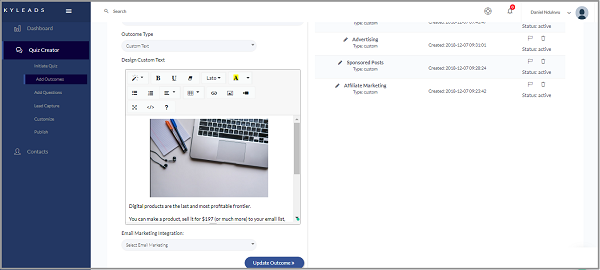
It improves the chances of them sharing and increases engagement on the follow-up emails you send.
Keep your target audience in mind when writing questions and answers.(recurring theme no?).
If you’ve been following along then you’ve already checked out your target audience and know who you’re talking to. Interactive quizzes are informal. Even if your brand isn’t adventurous, it’s a rare opportunity for you to loosen up.
Ask questions using words and phrases your target quiz taker would use naturally. If they would use contractions then you use contractions. If they describe carbonated water with food coloring as soda or pop then describe it the same way.
Go from easy to hard
Start your interactive quiz with easy questions so your quiz takers can warm up to your quiz.
Make sure your questions are clear and straightforward. This isn’t an eight grade English Literature test. Both you and your quiz taker want to leave the experience with a positive impression.
When it doubt, stick to questions that can be answered with yes, no, or maybe. You can also use agree or disagree as answers.
That doesn’t mean the questions should be boring. Start with an exciting question and end with an exciting question.
Allow your brand to shine
You want your interactive quiz to be a positive touchpoint between your audience and your brand. We touched on using language your audience would understand and allowing yourself to loosen up.
At the same time, you should avoid current pop culture references because it’ll limit the shelf life of your quiz. Instead, incorporate themes that are at the essence of your brand.
If you’re environmentally conscious then find a way to incorporate that type of question.
If creating lasting success is one of the pillars of your brand then make that a part of your quiz.
Your brand is unique and by associating with you, your audience uses you as a reflection of their self-identity. Reinforce the qualities that brought them to you in the first place.
Number of questions (7-10)
This is a hotly debated topic. Some sources say use seven questions. Some sources ten. We have our own data which we’ll release eventually.
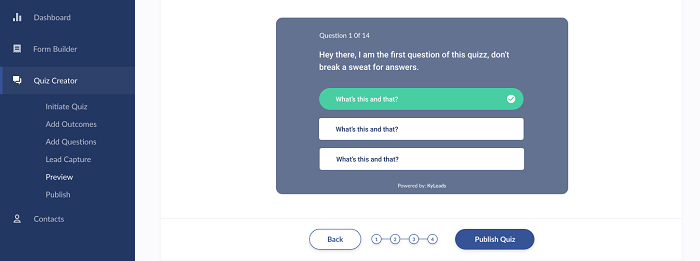
Until then, stick with between 7-10 questions. This is long enough to feel like you’ve asked proper questions and short enough to prevent fatigue.
This is a rule of thumb and you should by all means test it yourself.
Creating the lead capture page that converts quiz takers
This is the moment of truth. All your hard work will be paid off here – or not.
Remember that pesky 2-4% conversion rate most websites suffer from? This is where you get 10x that number on the conservative end.
There are two driving factors that make interactive quizzes for lead generation so powerful.
The first one is a psychological phenomenon known as the sunk cost fallacy. The sunk cost fallacy states that we continue an action because of the time and resources we’ve already invested in it. In this instance, the sunk cost isn’t much but you’re producing micro commitments with every answered question.
Have you ever started something and decided not to quit because you’ve already spent so much time on it?
The second driving factor is because the quiz is personal. You want the results because they’re for you and you alone. They’re not for John, Lucy, or Dave. By virtue of taking the quiz, most of the hard work is already done. With your lead capture page, it’s just to seal the deal.
How to craft the headline
We’ve written on headline formulas before so I suggest you check that out for a solid understanding of how to write a good headline.
With quizzes, you need to tie the lead capture page to the result they want to achieve. If they’re looking to buy a little black dress then you can say something like:
“Let us know where we should send your personalized little black dress recommendation”
I’m not a fashionista. Don’t use that heading. The point is, your ask ties it into the entire reason they’re taking the quiz. It works much better than “sign up for our mailing list.”
How to craft the description
The description reinforces the promise you made in the heading. Using the same example from above, your description can let them know you’ll send their personalized recommendation and give them tips to make the most of their little black dress.
How to promote your interactive quiz
You spent a lot of time and energy creating your quiz. It’s time to post it on your website and get 10,000 leads right? I wish.
It takes a tiny bit more work than that. There are countless ways to promote your interactive quiz and get tons of leads. We’ll touch on a few.
Facebook has billions of users. You only want a teeny tiny portion. If you’re already active on Facebook then dropping your link in relevant groups is an easy win for you. Just make sure you preface it with an engaging description/comment before you place your link.
Tell the viewer what the quiz is about, what they stand to gain, and why it matters.
If you’ve got a few dollars then you can also create a post on your page and boost it. Remember, quizzes are built to be shared.
Twitter is notoriously fickle. It can take you from zero to one hundred real quick. Share your quiz on Twitter multiple times while experimenting with different hashtags and mentioning relevant influencers. All it takes is for one person to start the movement.
Pinterest is built to send people to different – interesting – websites. The most important benefit is that a Pin has a much longer shelf life than almost any other social network. It can continue to get pinned over and over again.
Use a tool like Canva to make compelling images for your interactive quiz and share them in relevant group boards. This has benefits well beyond just your quiz. You can use the group boards you join to build your own following and promote other content.
Email list
This is meta. You’re using your email list to promote your newest lead magnet. The power in this approach is that your list will be much more willing to part with their email address. You can then resegment them and send better emails.
In addition to that, they’ll promote their results on their social media channels and help you get the word out.
Write a blog post about it
Another quick win is to write a blog post about your quiz and promote the post. Use it as a content upgrade to add more value to your post. You’ll continue to get traffic to the post and leads long after your initial push.
If you don’t have a lot of traffic right now, don’t worry, after an initial promotional push, the backlinks and traffic will come. Interactive content truly is epic.
If your current traffic levels are low, there’s no need for concern. With a strategic initial promotional effort, you’ll soon see an increase in backlinks and traffic. An interactive content writing agency delivers truly epic results, turning what was once static into dynamic interactions that captivate and retain audiences.
Generating instant revenue from your interactive quiz
59% of shoppers who experienced personalization say it affects their purchasing behavior. 90% of them say they’ve bought on impulse while shopping online.
74% of online buyers say they get frustrated with brands who show them online results that have nothing to do with their preferences or purchasing behavior.
What does this mean for you?
The data is telling us that people want products and services tailored to their unique needs. They don’t want the ten thousand other products that could be for them.
Your quiz gives you enough insight to recommend a product right away. The only caveat is that you won’t be able to sell a high ticket item.
Enter the world of front-end offers.
A front-end offer (also known as a tripwire offer) is relevant to your main products but much cheaper. This could be a discounted game for your console. It could be a cheap Ebook that compliments your signature course. It can even be an accessory that compliments the little black dress.
There are two things you need to get right with a front-end offer.
It needs to be relatively inexpensive. This doesn’t mean cheap. If you’re selling $1,000 bags then it wouldn’t make sense for your brand to offer $5 bracelets.
The second thing is it needs to be relevant to the next product you plan on selling. The reason many people don’t see the benefits of front-end offers is because they’re irrelevant to the main offer.
If they buy a front-end offer that’s an Ebook on dog obedience, they probably don’t want a course on cat obedience. It sounds obvious but this is an important point.
If you use advertising to drive traffic to your quiz then the front end offer can offset some of your ad costs.
Marketing to your leads after they’ve opted in through your quiz
When you create your quiz correctly, the leads you get are segmented by outcome. Apart from getting the contact information, segmentation allows you to send better email messages.
- Your open rates go up
- Your click-through rates go up
- Your revenue increases
Segmentation is like the holy grail of email marketing. Traditionally, it can be hit and miss. With quizzes, you get it right from the beginning.
So what do you do with those segmented contacts? Send them to a sequence that all your contacts enter? That would be doing yourself (and your contacts a disservice).
Instead, send them emails tailored to what they’ve already revealed about themselves. With KyLeads, you have the built-in ability to segment users based on their outcome.
We like to use what we call Humanity Marketing (HM for short). It’s simply the process of tailoring your marketing based on real human relationships. The result is you send better emails, get better responses, and generate more revenue.
It’s a little much to get into here, let’s look at a welcome email series you can use.
- Immediate welcome emails that reinforce the core benefit they’ll get. Give a bonus if possible. Use this as an opportunity to tell a story.
- Talk to the specific outcome they got from the quiz and provide a quick win relevant to them.
- Instills buying beliefs (these are the things they need to agree with/understand in order to buy from you)
- Continue building buying beliefs, show real-world examples, and if possible give a bonus/resource
- Instill more buying beliefs and make a soft pitch for your mid-tier product
- Final buying belief and an ask for a webinar/consultation/whatever makes sense to you that’ll move them to the bottom of the funnel to purchase stage.
This is a very general overview of how to email your new leads. It goes much deeper than this but we’re strapped for space. I’ll make sure to create a post that dives deep into this process.
Conclusion
There you have it, a quick rundown of how to use interactive quizzes to generate qualified leads for your business. The process is straightforward:
Choose a relevant topic that’ll appeal to your audience
Develop multiple outcomes that shed light on their personality
Create engaging questions
Promote it all over the place
Send emails related to the outcome they got through the interactive quiz
Interactive quizzes consistently outperform traditional lead capture methods. It takes a little bit of time to get it perfect. Once you do, it’ll generate leads for a long time to come.
Let me know if you’d like to add anything or if you hit any snags while making quizzes in the comments.
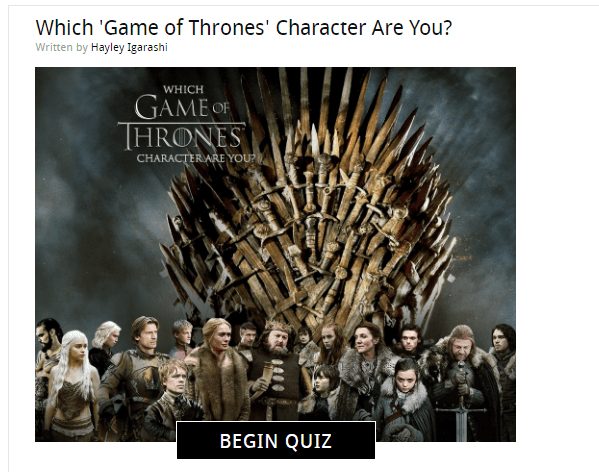
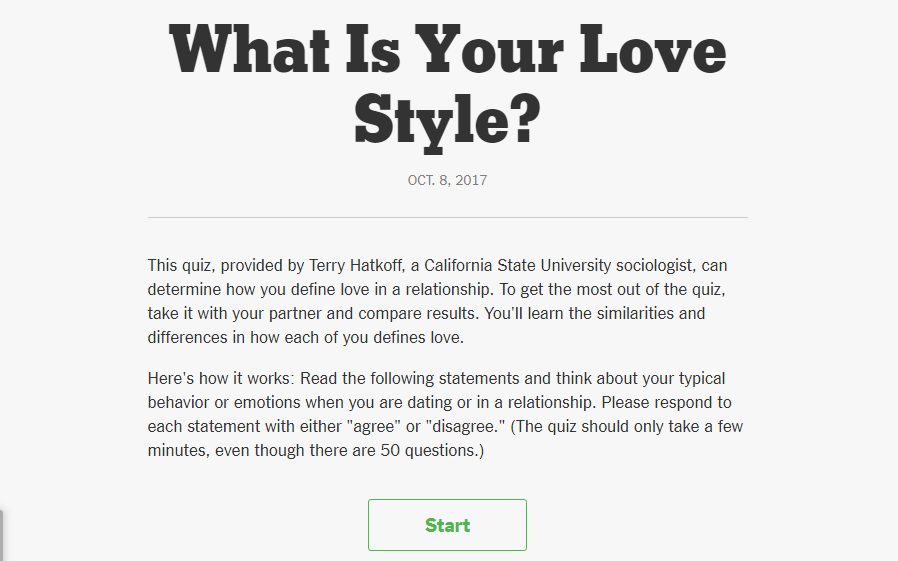
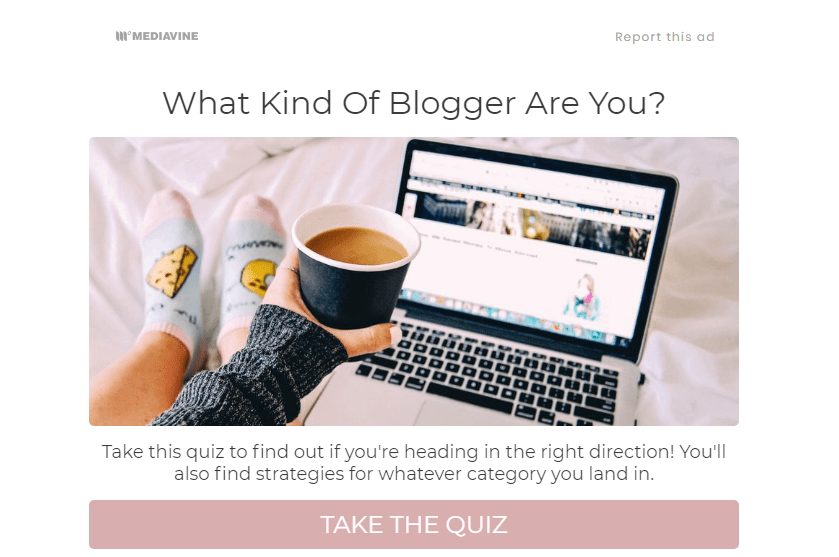
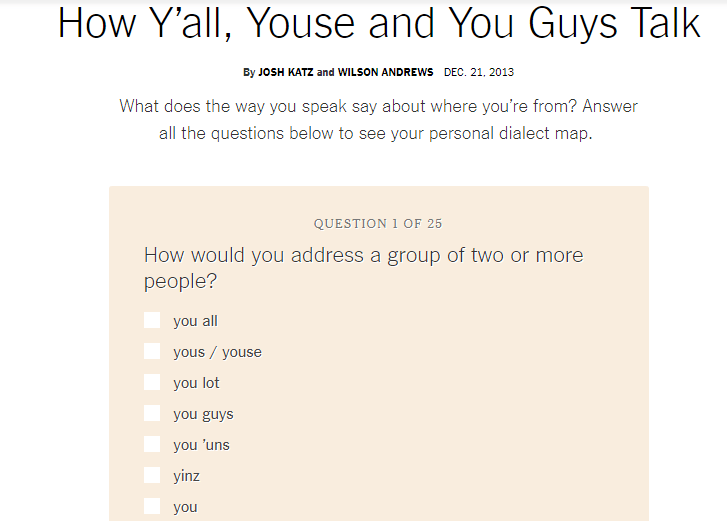
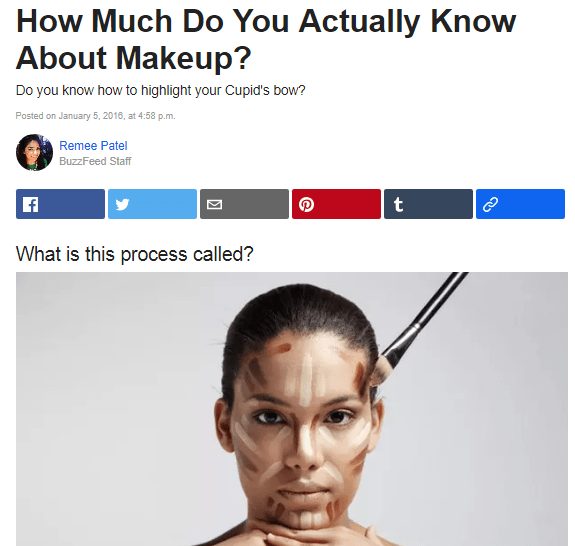
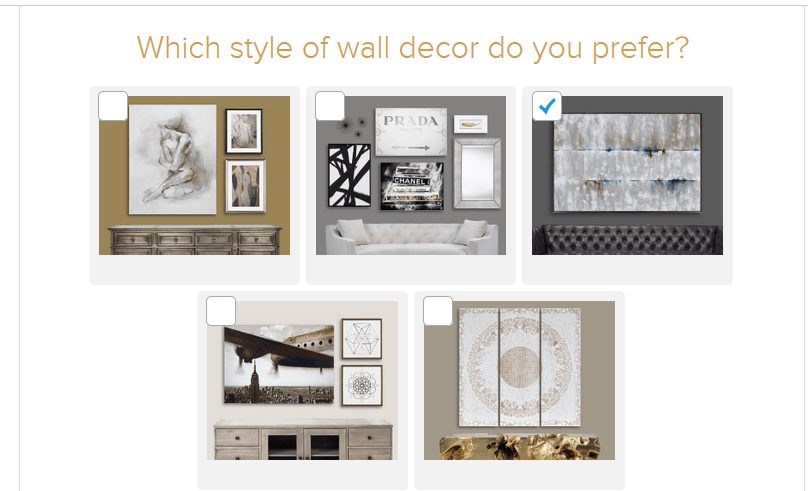
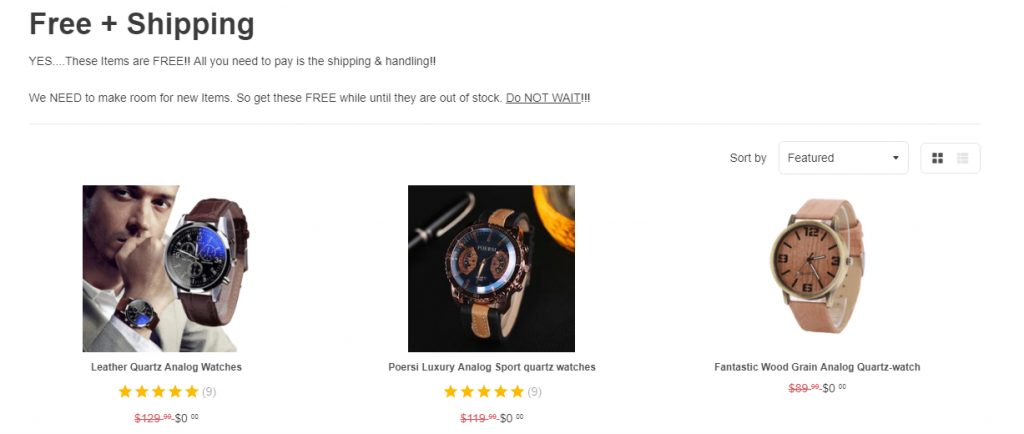
Great Article!
Thanks for reading.
Nice Article! you have covered almost everything!
Hello Daniel, Nice post. I know quiz helps to get more leads to the business but there are so many small things which we needed to be considered before and most of the time those things are gone to be missed. But yes, you covered all points in it. Thanks again for sharing this article with us.
You’re right, there are quite a few variables and many of them can be missed if you don’t have a solid idea of what you’re doing. Thanks for reading.